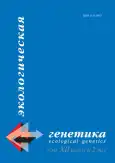Genetic and environmental determinants in the formation of differences in aggression in same-sex siblings
- Authors: Shustikova M.V.1
-
Affiliations:
- V. N. Karazin Kharkov National University
- Issue: Vol 12, No 2 (2014)
- Pages: 60-67
- Section: Articles
- URL: https://journals.rcsi.science/ecolgenet/article/view/2449
- DOI: https://doi.org/10.17816/ecogen12260-67
- ID: 2449
Cite item
Full Text
Abstract
Keywords
Full Text
##article.viewOnOriginalSite##About the authors
Marina Valentinovna Shustikova
V. N. Karazin Kharkov National University
Email: m_v_shustikova@mail.ru
Researcher
References
- Аммон Г. (1995) Динамическая психиатрия. Под ред. В.Д. Вида. CПб.: Психоневрологический институт им. В.М. Бехтерева.
- Кернберг О.Ф. (1998) Агрессия при расстройствах личности. М.: Класс.
- Кудрявцева Н.Н. (2004) А Лоренц-то был прав! Или накапливается ли агрессивная энергия? Генетика. Т. 40. С. 808-815.
- Кудрявцева Н.Н., Филиппенко М.Л., Бакштановская И.В. с соавт. (2004) Изменение экспрессии моноаминергических генов под влиянием повторного опыта агонистических взаимодействий: от поведения к гену. Генетика. Т.40. С. 732-748.
- Лакин Г.Ф. (1990) Биометрия. М.: Высшая школа.
- Психологические тесты (2002) Под ред. А.А. Карелина. Т.1. М.: ВЛАДОС.
- Фогель Ф., Мотульски А. (1990) Генетика человека. Т.3. М.: Мир.
- Шустикова М.В. (2008) Наследуемость физической агрессивности: гендерные отличия. Под ред. Е.В. Лосевой, Н.А. Логиновой. Нейронаука для психологии и медицины. М.: МАКС Пресс; С. 337-338.
- Шустикова М.В. (2009а) Влияние эффекта очередности рождения на корреляционные взаимосвязи по уровню агрессивности между родителями и потомками в семьях с однополыми сиблингами. Под ред. Е.В. Лосевой, Н.А. Логиновой. Нейронаука для психологии и медицины. М.: МАКС Пресс; С. 251-252.
- Шустикова М.В. (2009b) Особенности формирования индивидуальных различий по уровню агрессивного реагирования у потомков семей с различной структурой. Под ред. В.А. Кунаха. Фактории експериментальної еволюції організмів. Київ: Логос; С.430-434.
- Шустикова М.В. (2010) Генетические и средовые факторы вариабельности уровня агрессивности в семьях с однополыми сибствами. Медицинская генетика, Материалы VI Съезда Российского общества медицинских генетиков (Ростов-на-Дону, 14-18 мая 2010 г.) C. 199.
- Bronfenbrenner U. & Cesi S.J. (1994) Nature-nurture reconceptualized: A bio-ecological model. Psychological Review. V. 101. Р. 568-586.
- Buckholts J., Meyer-Lindenberg A. (2008) MAOA and the neurogenetic architecture of human aggression. Trends in neuroscience. V. 31 (3) P. 120-129.
- Coccaro E.F., Bergeman C.S., Kavoussi R.J. et al. (1977) Heritability of aggression and irritability: A twin study of the Buss-Durkee aggression scales in adult male subjects. Biol. Psychiatry. V. 41. P. 273-284.
- Daly М., Wilson М. (1995) Discriminative parental solicitude and the relevance of evolutionary models to the analysis of motivational systems. In: M. Gazzaniga, editor. Cognitive Neurosciences. Cambridge: MIT Press; p. 1269-1286.
- DeLisi M., Beaver К.М., Vaughn M. G., Wright J. P. (2009) All in the family: Gene x environment interaction between DRD2 and criminal father is associated with Five antisocial phenotypes. Criminal Justice and Behavior. V. 36. P. 1187-1197.
- Falconer D.S. (1960) Introduction to Quantitative Genetics. Edinburgh: Oliver and Boyd.
- Finkel D., McGue M. (1997) Sex differences and nonadditivity in heritability of the Multidimensional personality Questionnaire scales. J. Personal. Social Psychol. V. 72. P. 929-938.
- Harris J.A., Vernon P.A., Boomsma D.I. (1998) The heritability of testosterone: a study of Dutch adolescent twins and their parents. Behavior Genetic. V. 28. (3) P. 165-171.
- Hur Y.M. (2006) Non-additive genetic effects on hostility in South Korean adolescent and young adult twins. Twin Res. Hum. Genet. V. 9. P. 637-641.
- Hur Y.M. (2007) Evidence for non-additive genetic effects on Eysenck Personality Scales in South Korean twins. Twin Res. Hum. Genet. V. 10. P. 373-378.
- Márquez C., Poirier G.L., Cordero M.I. et. al. (2013) Peripuberty stress leads to abnormal aggression, altered amygdala and orbitofrontal reactivity and increased prefrontal MAOA gene expression. Translational Psychiatry. Posted 15.01.2013, cited 10.09.2013. URL: http://www.nature.com/tp/journal/v3/n1/full/tp2012144a.html.
- Pan L., Ober C., Abney M. (2007) Heritability estimation of sex-specific effects on human quantitative traits. Genetic epidemiology. V. 31. Р. 338-347.
- Parens H. (2008) The development of aggression in early childhood. New York: Jason Aronson.
- Plomin R., Danies D. (1987) Why are children in the same family so different from one another? Behavioral and Brain Sciences. V. 10. (1) Р. 1-16.
- Reiss D. (2003) Child effect on family systems: Behavioral genetic strategies. In: A. Crouter, A. Booth, editors. Children’s influence on family dynamics: the neglected side of family relationships. NJ: Lawrence Erlbaum Associates; р. 3-25.
- Robello I., Boomsma D.I. (2006) Genetic analysis of anger: Genetic dominance or competitive sibling interaction. Behavior Genetics. V. 36. P. 216-228.
- Rutter М., Thapar A., Pickles A. (2009) Gene-environment interactions: Biologically valid pathway or artifact? Arch. Gen. Psychiatry. V. 66. P. 1287-1289.
- Sjöberg R.L., Ducci F., Barr C.S. et al. (2008) A non-additive interaction of a functional MAO-A VNTR and testosterone predicts antisocial behavior. Neuropsychopharmacology. V. 33. Р. 425-430.
- Weiss L., Abney M., Cook E. (2005) Sex-specific genetic architecture of whole blood serotonin levels. Amer. Jour. Human Genetics. V. 76. (1) P. 33-41.
- Weiss L., Pan L., Abney M., Ober C. (2006) The sex-specific of quantitative traits in humans. Nature Genetics. V. 38. (2) P. 218-222.
Supplementary files






